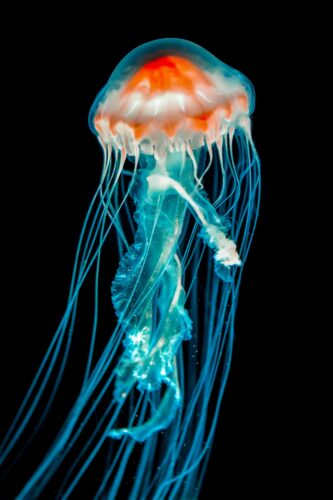Image Courtesy of Unsplash.
You’ve probably seen it in nature documentaries: a translucent fish meanders through the darkness, searching for scraps of food in the wasteland of the deep ocean. The screen sparkles with flakes of decaying matter that drift above the ocean floor, to be consumed by sparse communities of microbes and strange, gelatinous creatures. The narrator explains that the deep ocean has an average temperature of just four degrees Celsius and that the water is under such pressure that it could crush anything but a few specialized vehicles.
More than two-thirds of the Earth’s surface is water, and our understanding of the organisms that live in its depths remains severely limited. But to Sabrina Imbler, a science journalist and former New York Times reporting fellow, the mystery of the murky waters is no cause for unease. Rather, as Imbler shows in their new collection of essays, How Far the Light Reaches: A Life in Ten Sea Creatures, the networks of resiliency that populate Earth’s waters provide a glimpse of the beauty that can flourish amid turbulence and oppression.
Each essay in the collection examines one creature and a corresponding piece of Imbler’s identity, drawing parallels between the unique ecology of the sea and Imbler’s lived experience. In the collection’s opening essay, Imbler notes that goldfish can grow to be long-lived, far-traveling giants when freed from the confinement of fishbowls. Interweaving poignant adolescent memories within the exposition of goldfish biology, Imbler suggests that a person’s identity, too, may flourish when freed from constraints. As Imbler recounts the process of defining their queer, mixed-race identity, they show that nature serves as a model for personal authenticity.
When the spotlight turns to the yeti crab, a tiny crustacean that ekes out an existence in the heated waters of hydrothermal vents, Imbler questions the notion that living in Earth’s most inhospitable environments is a matter of mere survival. The yeti crab is an eternal dancer, waving its pincers in circles continuously to harvest microbes on its hairlike filaments, living in a place scientists long thought impossible. “I prefer to think of it not as a last resort but as a radical act of choosing what nourishes you,” Imbler writes.
The unexpected triumph of the yeti crab comes interspersed with Imbler’s memories of the queer, mixed-race communities they have found hidden in American cities. Imbler touches upon the struggles they have faced grappling with racism, sexism, gentrification, fetishization, and other forms of intolerance in contemporary America. Movingly, Imbler reflects on resilient aquatic populations as symbols of solace and hope.
Imbler’s sprawling exploration of the creatures that inhabit the sea questions the way our definitions of normality restrict us. An examination of hybrid fish in one essay becomes a critique of the impulse to categorize nature’s disorder. For Imbler, the vast and beautiful world of sea creatures offers a call for a deepened understanding of our most authentic identities—abnormal, confounding, and gelatinous as they may seem.

